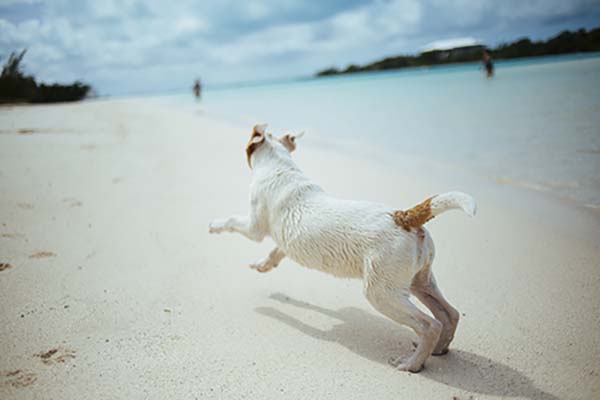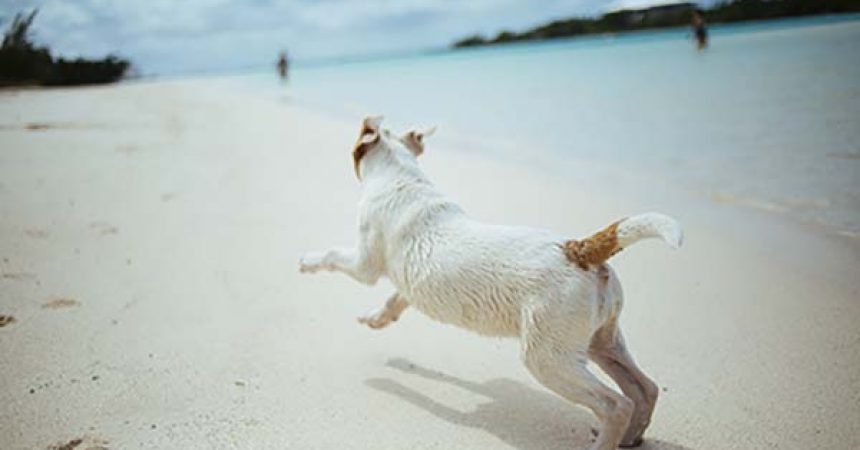The process for taking a pet to Hawaii is intense and takes a minimum of 4.5 to 5 months to complete. If you’ve put Hawaii on your wish list or it’s a possibility for your next assignment AND you have a pet you want to take with you, you should start thinking about the import and quarantine processes now!!
Starting now, make sure that when your pet receives rabies vaccinations, your vet records the vaccine name, lot or serial number, booster interval, vaccination date, and vaccine lot expiration date on an official certificate. Also, be sure that you’ll have access to your pet’s two most recent, original rabies vaccination certificates (if not, start making arrangements to access them).
It’s also important to realize that, since this process has minimum requirements for its timeline, puppies and kittens won’t be able to accompany you until they are old enough to have had 2 rabies vaccines (and don’t try to cheat the system … the vaccines must have been administered at least 30 days apart). If you have a puppy or kitten, it would be a good idea to review all of the requirements listed in this brochure with your vet to determine when (or if) you should take your puppy or kitten with you.
Here’s the timeline:
_________________________________________________________________________________________________
6 Months Prior to Departure
Check in with your vet to let them know about the upcoming requirements you’ll be trying to meet. Give their team a little bit of time to familiarize themselves with this process (or better yet, use this time to find a vet who is already familiar with the process). If your pet doesn’t already have a microchip, schedule an appointment within the next week to have one put in. Go ahead and schedule an appointment for the 5-month mark to be sure that the next step goes smoothly.
_________________________________________________________________________________________________
5 Months Prior to Departure
At your pet’s appointment, the vet will need to take a blood sample for an OIE-FAVN Rabies Blood Test. Your vet must send the blood test, labeled with the destination as HAWAII, to either:
- KSU
OR
- The DOD Laboratory
You and your vet can find more info about the labs and appropriate forms by following this link and looking under the heading, “Forms > OIE-FAVN Testing Forms.” This test must be mailed to the lab and completed before your pet’s 120-day waiting period can begin. Your pet cannot arrive in Hawaii before the end of this period and still qualify for the 5-days-or-less and direct release programs, so it’s important to ensure that your vet mails the sample out as soon as possible.
**Retain a copy of this successful blood test result showing the pet’s microchip number from the veterinarian for your records. Do not contact the laboratory directly.
_________________________________________________________________________________________________
4 Months Prior to Departure
Be sure that your pet’s rabies vaccination will be current upon your arrival in Hawaii. If your pet will need another rabies vaccination, be sure that it is administered more than 90 days before your arrival in Hawaii.
As you plan your trip and look at booking tickets, be sure to:
- Book them for arrival at Honolulu International Airport before 3:30 pm. It can take up to an hour for your pet to be transferred to the correct department for release, and that department does not accept new pets for release after 4:30 pm. If your pet arrives after 4:30 pm, it will be entered into the 5-days-or-less program and transferred to another facility for pick-up.
- Check the airline’s requirements for traveling with your pet. Some airlines require a rabies vaccination less than 10 days prior to departure. If you’ve determined that your pet will need another rabies vaccination to be current upon your arrival, you should not choose airlines with this requirement. Your pet’s vaccination must be administered at least 90 days prior to arrival for the state of Hawaii, and the vaccination may not be administered again within the 10-day period. Also, be aware that some airlines will not transport certain types of dogs; be sure to check each airline’s breed restrictions.
Schedule an appointment with your vet for 13 or 14 days before your scheduled arrival date in Hawaii (preferably for the morning). Read the list of documents you’ll need to obtain at this appointment below to give your vet advanced notice that you’ll require them during this visit. You can also give your vet a summary of your upcoming needs with this document.
If your pet is in the 5-days-or-less program, contact an approved animal hospital on Oahu to register your pet for any necessary care during quarantine.
_________________________________________________________________________________________________
18-15 Days Prior to Departure
Complete the Dog & Cat Import Form AQS-278 and have it notarized. NOTE: Only signees on this notarized document will be able to pick the animal up from the airport.
Obtain a cashier’s check or money order for either $224 (5-days-or-less program) or $165 (direct release program) per pet. Include your pet’s microchip number with the payment to ensure proper credit. Make payments payable to: Hawaii Department of Agriculture. You will have the option to pay upon arrival in Hawaii, but the authorities strongly recommend mailing your payment with the other necessary documents ahead of time (in a coming step).
_________________________________________________________________________________________________
14-13 Days Prior to Departure
At your pet’s scheduled vet appointment, be sure that the following happen:
- The vet must administer a treatment for ticks with a “product containing Fipronil or an equivalent, long-acting product labeled to kill ticks,” according to Hawaii’s regulations.
- You need to obtain the following documents from your vet:
- Original ink signature or carbon copy rabies vaccination certificates for the 2 most recent rabies vaccinations the pet received. (Photocopies and computer-generated certificates are not accepted.) The vaccination certificates must have the vaccine name, lot or serial number, booster interval, vaccination date and vaccine lot expiration date listed.
- An original health certificate in English, done within 14 days of arrival in Hawaii including rabies vaccine name, lot or serial number, booster interval, vaccination date and expiration date is required. The certificate must also list the product name and date of treatment for the tick treatment your vet administers during this appointment.
- A copy of your pet’s OIE-FAVN Rabies Blood Test (if you haven’t collected one already).
- Gather the following documents and make copies of them for your own records:
- Completed Dog & Cat Import Form AQS-278 (must be notarized).
- 2 original rabies vaccination certificates with actual veterinarian signature in ink.
- Payment of fees ($165 per pet in advance for direct airport release or $224 for 5-day-or-less program) by cashier’s check or money order (no personal checks are accepted). Include your pet’s microchip number with the payment to ensure proper credit. Payable to: Department of Agriculture.
- You may also include the original health certificate, or you can choose to keep it with you and hand it in upon arrival, but your animal will not be released without the original document (no copies).
- Head to your local post office before they close that day and mail the ORIGINALS of all of the documents you choose to include to:
Animal Quarantine Station
99-951 Halawa Valley Street
Aiea, HI 96701
- Express mail the documents with a return receipt (to ensure that they arrive) so that they arrive at least 10 days prior to your expected arrival date in Hawaii.
- NOTE: These documents must arrive at the Animal Quarantine offices at least 10 days prior to your arrival date. If they arrive later, your pet may not qualify for direct release and may be entered into the 5-days-or-less program.
_________________________________________________________________________________________________
Day of Arrival (!!!)
- Be sure that your copies of all documents are packed in your carry on luggage.
- If your pet is eligible for direct release, find a baggage cart (if your pet’s crate is large) and head to the Airport Animal Quarantine Holding Facility.
- Undergo the process for pet pick-up, but be sure not to let your pet out of its carrier until you have left airport property.
- If your flight is delayed and you arrive after 3:30 pm, your pet will be transferred into the 5-days-or-less program and sent to the Animal Quarantine Station. You will then need to pay additional fees (of at least $17.80 per day that your pet remains in the government facility).
- If your pet has been transferred to or is in the 5-days-or-less program, you may pick it up at the Animal Quarantine Station at: 99-951 Halawa Valley Street, Aiea, HI 96701. Their phone number is: 808.483.7151. Their hours are:
- Monday – Friday: 9:00 am – 11:00 am & 1:00 pm – 4:30 pm
- Saturday – Sunday (and state holidays): 8:00 am – 10:00 am & 12:00 pm – 3:30 pm




